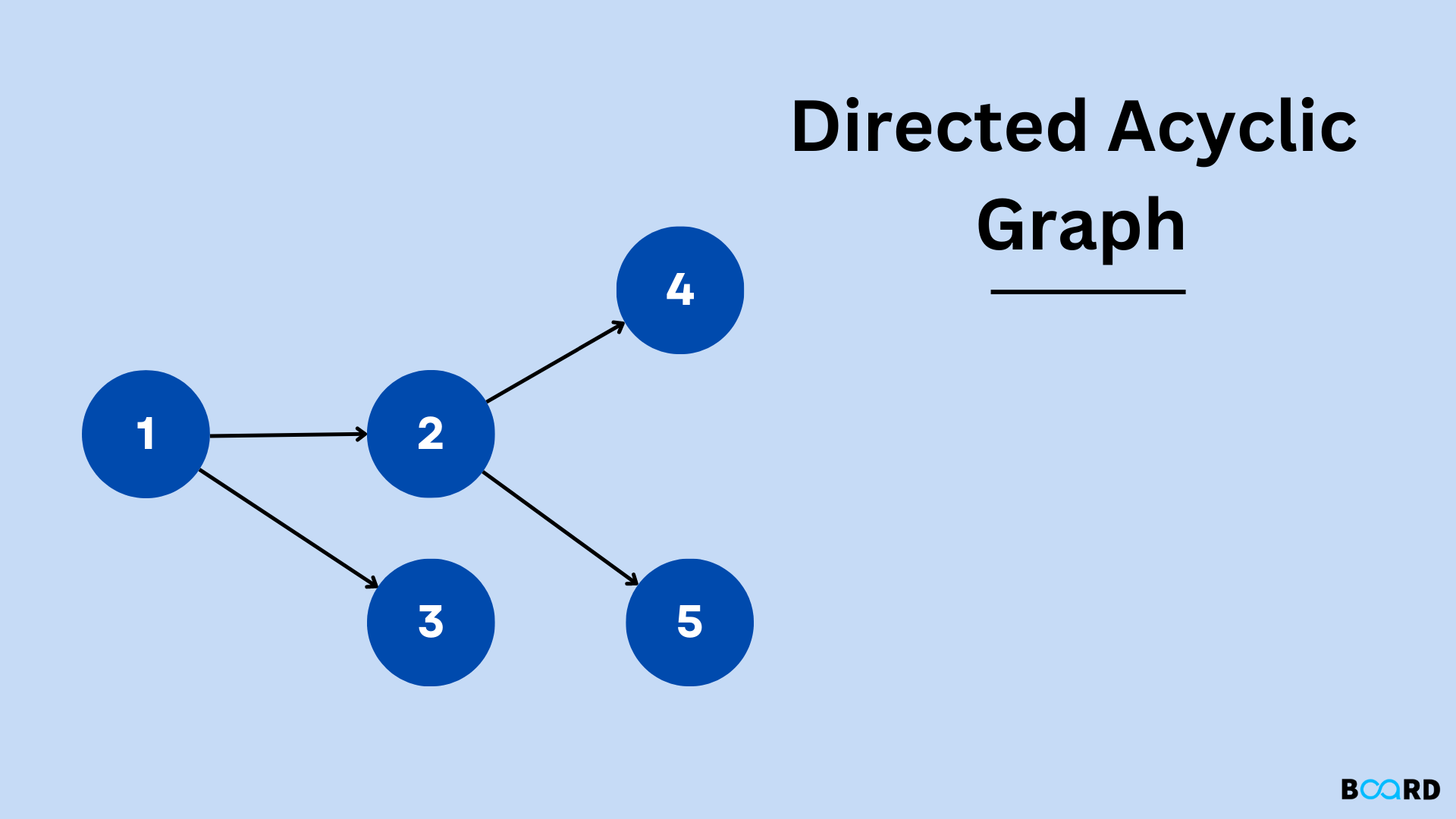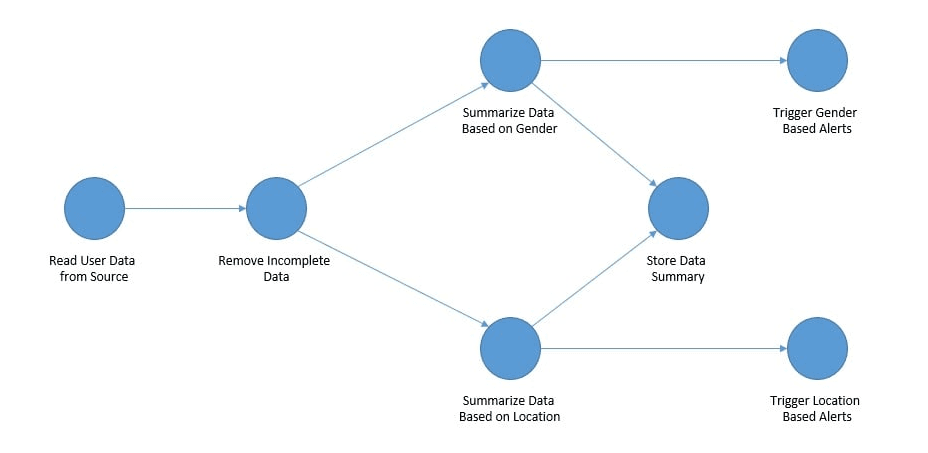What is a Directed Acyclic Graph?
A Directed Acyclic Graph is a collection of points, called vertices, connected by lines, called edges. These edges have a direction, meaning they point from one vertex to another.
The term "acyclic" means there are no cycles; you can’t start at one vertex and loop back to it through other vertices. Once you move forward, you can't return.

Importance of Directed Acyclic Graph in Computer Science and Data Structures
In this section, you can find the importance of directed acyclic graphs in computer science and data structures.
Organizing Data Efficiently
Directed acyclic graphs are essential for organizing data efficiently as:
- Task Scheduling: Ensures tasks are completed in the right order by representing dependencies.
- Dependency Management: Helps in visualizing and managing dependencies in complex systems.
Optimizing Workflows
Directed acyclic graphs optimizes workflows by:
- Project Management: Maps out steps in a project to ensure proper sequencing.
- Resource Allocation: Identifies critical tasks and allocates resources effectively.
Version Control Systems
Importance if DAG in version control systems is as follows:
- Change Tracking: Keeps track of changes in projects using commits as points in the graph.
- Branching and Merging: Manages different branches and merges them without conflicts.
Database Query Optimization
For database query optimization in directed acyclic graphs is done through:
- Efficient Data Retrieval: Maps out the best paths for retrieving information from databases.
- Query Planning: Optimizes the order of operations in a query for faster results.
Enhancing Security
DAG enhances security through:
- Protocol Design: Ensures security checks occur in the correct order.
- Access Control: Manages access permissions based on dependencies and hierarchies.
Additional Uses
Additional uses of Directed acyclic graphs are:
- Compiler Design: Represents program structures to optimize code generation.
- Network Routing: Determines efficient routing paths without loops.
Components and Structure of Directed Acyclic Graph
Understanding the basic building blocks and arrangement of a Directed Acyclic Graph (DAG) is like knowing the blueprint of a road network without any roundabouts. So here are the components and structure of directed acyclic graphs:
- Nodes: Think of nodes as the points or locations on a map. Each node represents a piece of information or a task.
- Edges: Picture edges as the roads or pathways connecting these locations. They show the direction from one node to another, indicating relationships or dependencies.
- Paths: Imagine following a route from one location to another on a map. A path in a DAG is like tracing a line from one node to another through the connecting edges.
- Reachability: It's like figuring out if you can travel from one place to another on a map. In a DAG, it means determining if there's a path between two nodes. If there is, they're reachable; if not, they're isolated from each other.
Subgraphs and Components of Directed Acyclic Graph

Exploring smaller sections and groupings within a DAG helps in understanding its structure better, like zooming in on neighborhoods in a city.
Subgraphs
Subgraphs of Directed acyclic graphs are as follows:
- Subgraphs: These are like smaller maps within a bigger one, focusing on specific areas or clusters of nodes and edges.
- Partitioning: It's like dividing a city into districts. Subgraphs help organize nodes and edges into manageable chunks for analysis or processing.
Components
Components of Directed acyclic graphs are the following:
- Connected Components: Imagine islands in an archipelago. These are sets of nodes where every node is reachable from every other node within the set.
- Isolated Nodes: These are like lone islands in the ocean, not connected to any other node. They form their own separate components in the DAG.
Applications of Directed Acyclic Graphs

This section brings to the applications of Directed acyclic graphs, so check it out:
Computer Science
The applications of Directed acyclic graph in computer science are the following:
- Dependency Resolution: Helps software manage dependencies between different modules or libraries, ensuring they're installed in the right order.
- Compiler Design: Used to represent program structures and optimize code generation, making programs run faster and more efficiently.
Project Management
The uses in project management are as follows:
- Task Scheduling: Organizes project tasks in a sequence, ensuring they're completed in the right order without conflicts or delays.
- Resource Allocation: Helps allocate resources effectively by identifying critical tasks and dependencies.
Blockchain and Cryptocurrencies
Blockchain and cryptocurrencies showcases the application as:
- Transaction Validation: In blockchain technology, DAGs help validate and record transactions securely without the need for a centralized authority.
- Scalability: Offers potential for scalable blockchain networks, allowing for faster transaction processing and lower fees.
Scheduling and Planning
The applications of Directed acyclic graph in scheduling and planning are the following:
- Job Scheduling: Used in systems to schedule tasks like batch processing, ensuring efficient resource utilization and timely completion.
- Route Optimization: Helps optimize delivery routes or travel itineraries, minimizing time and resources required.
Tools and Software of Directed Acyclic Graph
In this section, you’ll find the tools and software of directed acyclic graphs.
Popular Tools for Directed Acyclic Graph Visualization and Analysis
The popular tools for directed acyclic graph visualization and analysis are the following:
- Graphviz: It’s like having a magic marker to draw out your DAG on a digital whiteboard. Graphviz creates clear visualizations of DAGs for easy understanding.
- DAGitty: Think of it as a virtual assistant for your DAG needs. DAGitty helps you draw, analyze, and interpret your DAGs with ease.
- Cytoscape: Picture a digital playground where you can explore and interact with your DAG. Cytoscape allows for dynamic visualization and analysis of complex networks, including DAGs.
Software Libraries Supporting DAGs
The software are the following:
- NetworkX: It’s like having a Swiss Army knife for DAG manipulation in Python. NetworkX offers a wide range of functions for creating, analyzing, and visualizing DAGs.
- Apache Spark: Imagine having a powerful engine to process and analyze massive DAGs with lightning speed. Apache Spark provides distributed computing capabilities for handling large-scale DAG workflows.
- TensorFlow Extended (TFX): Think of it as your personal assistant for machine learning pipelines. TFX includes tools for building and managing complex DAG workflows in machine learning projects.
Frequently Asked Questions (FAQs)
How does a Directed Acyclic Graph differ from a blockchain?
Unlike blockchains that structure data in linear blocks, DAGs enable a lattice-like structure allowing for parallel transactions and potentially higher scalability.
What are the major advantages of using Directed Acyclic Graphs?
DAGs offer scalability, faster transactions, potentially lower fees, and can be more energy-efficient compared to traditional blockchain technology.
In which industries are Directed Acyclic Graphs most commonly used?
DAGs are widely used in industries like cryptocurrency, IoT, data processing, and supply chain management for their efficiency and scalability.
How do Directed Acyclic Graphs manage transactions without blocks?
DAGs manage transactions by linking individual transactions directly to each other in a graph format, enabling simultaneous processing and verification.
What are the challenges of implementing Directed Acyclic Graph technology?
Challenges include network security, achieving consensus without traditional mining, and ensuring all nodes have consistent data without a blockchain's linear structure.
